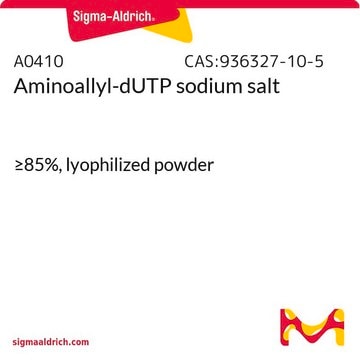11051440001
Roche
2′-Desoxyadenosin-5′-triphosphat Natriumsalz -Lösung
=98%, solution, 100 mM, suitable for DNA sequencing, suitable for DNA amplification
Synonym(e):
dATP
About This Item
Empfohlene Produkte
Qualitätsniveau
Beschreibung
Lithium salt
Assay
98%
Form
solution
Verwendung
sufficient for 6,250 standard reactions (PCR)
Verpackung
pkg of 250 μL (25 μmol; 100 mM)
Hersteller/Markenname
Roche
Konzentration
100 mM
Methode(n)
DNA amplification: suitable
DNA sequencing: suitable
DNA synthesis: suitable
PCR: suitable
Lagertemp.
−20°C
SMILES String
[Na+].Nc1ncnc2n(cnc12)[C@H]3C[C@H](O)[C@@H](COP(O)(=O)OP(O)(=O)OP(O)([O-])=O)O3
InChI
1S/C10H16N5O12P3.Na/c11-9-8-10(13-3-12-9)15(4-14-8)7-1-5(16)6(25-7)2-24-29(20,21)27-30(22,23)26-28(17,18)19;/h3-7,16H,1-2H2,(H,20,21)(H,22,23)(H2,11,12,13)(H2,17,18,19);/q;+1/p-1/t5-,6+,7+;/m0./s1
InChIKey
YJWCICGGRLOGEH-VWZUFWLJSA-M
Suchen Sie nach ähnlichen Produkten? Aufrufen Leitfaden zum Produktvergleich
Verwandte Kategorien
Allgemeine Beschreibung
Anwendung
Biochem./physiol. Wirkung
Qualität
- ≤98% dATP (HPLC), ≤1.5% dADP (HPLC), ≤0.5% dAMP (HPLC)
- Absorbance determination A250/A260, A280/A260, A290/A260
- DNase activity negative, according to the current Quality Control procedures
- Suitability for PCR
Einheitendefinition
Sonstige Hinweise
For your convenience, some of our deoxynucleotides are also available in:
- nucleotide sets (all 4 nucleotides in separate vials)
- ready-to-use nucleotide mixes (premixed solutions of all 4 nucleotides)
- kits (dNTPs, buffer, and polymerase in separate vials)
- ready-to-use mixes [polymerase, nucleotides, and buffer (premixed 2x solutions)]
Lagerklassenschlüssel
12 - Non Combustible Liquids
WGK
nwg
Flammpunkt (°F)
No data available
Flammpunkt (°C)
No data available
Analysenzertifikate (COA)
Suchen Sie nach Analysenzertifikate (COA), indem Sie die Lot-/Chargennummer des Produkts eingeben. Lot- und Chargennummern sind auf dem Produktetikett hinter den Wörtern ‘Lot’ oder ‘Batch’ (Lot oder Charge) zu finden.
Besitzen Sie dieses Produkt bereits?
In der Dokumentenbibliothek finden Sie die Dokumentation zu den Produkten, die Sie kürzlich erworben haben.
Kunden haben sich ebenfalls angesehen
Unser Team von Wissenschaftlern verfügt über Erfahrung in allen Forschungsbereichen einschließlich Life Science, Materialwissenschaften, chemischer Synthese, Chromatographie, Analytik und vielen mehr..
Setzen Sie sich mit dem technischen Dienst in Verbindung.








